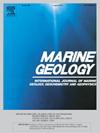使用摄影测量的深海定量构造地质:法属圭亚那Buteur岭多期构造演化的意义
IF 2.2
3区 地球科学
Q2 GEOSCIENCES, MULTIDISCIPLINARY
引用次数: 0
摘要
Buteur山脊是一个长7公里,宽6公里的凸起,位于法属圭亚那近海德梅拉高原的东部裂谷边缘。这一边缘形成于下白垩纪。2023年初,海洋研究巡航船DIADEM使用载人深潜器(鹦鹉螺号)取样并直接观察了这个3750米深的山脊的东侧。本文提出了一种新的水下摄影测量方法。这种方法结合了相机和潜艇的运动来产生分米以下海底的摄影测量3D模型。所提出的水下摄影测量方法可以用于过去和未来的视频记录,只要记录水下设备和摄像机的运动。从三维重建中获得的数据可以重建Buteur岭的详细地层和构造框架。布特尔山脊的东侧完全由沉积层组成。层级构造分析表明,可能与南北向古流有关的进动构造。在脊尺度上,结合地震观测,构造分析表明,Buteur脊是一个多期构造演化的结果。我们强调白垩纪以东倾断裂为界的倾斜块体与后裂谷单元重叠。同裂谷单元通过裂谷后不整合与东倾的后裂谷单元接触。随后的倾斜和断层再活动抵消了裂谷后不整合和裂谷后单元,形成了现在的布特尔岭的隆起。本文章由计算机程序翻译,如有差异,请以英文原文为准。
Quantitative structural geology in the deep ocean using photogrammetry: Implications for the polyphased tectonic evolution of the Buteur Ridge, French Guiana
The Buteur Ridge is a 7 km-long and 6 km-wide relief on the eastern rifted margin of the Demerara Plateau, offshore French Guiana. This margin was formed during the Lower Cretaceous. In early 2023, the oceanographic cruise DIADEM used a manned deep submersible (Nautile) to sample and directly observe the eastern flank of this 3750 m-deep ridge.
This study presents a new underwater photogrammetric method developed from the Nautile video records. This method incorporates both camera and submarine movements to produce photogrammetric 3D models of the seafloor below decimetre scale. The presented underwater photogrammetric method can be used for both past and future video records, as long as both underwater device and camera movements are recorded.
The data obtained from the 3D reconstructions allow to reconstruct detailed stratigraphic and structural framework of the Buteur Ridge. The eastern flank of the Buteur Ridge is entirely composed of sedimentary layers. Structural analysis at bed scale suggests prograding structures likely associated with a N-S-directed paleocurrent. At ridge scale, structural analysis combined with seismic observations suggests that the Buteur Ridge is the result of a polyphased tectonic evolution. We highlight that Cretaceous tilted blocks, bounded by east-dipping faults, are overlapped by a post-rift unit. The syn-rift units are in contact with the east-dipping post-rift unit by a post-rift unconformity. Subsequent tilt and fault reactivation offset both the post-rift unconformity and the post-rift unit, resulting in the present relief of the Buteur Ridge.
求助全文
通过发布文献求助,成功后即可免费获取论文全文。
去求助
来源期刊

Marine Geology
地学-地球科学综合
CiteScore
6.10
自引率
6.90%
发文量
175
审稿时长
21.9 weeks
期刊介绍:
Marine Geology is the premier international journal on marine geological processes in the broadest sense. We seek papers that are comprehensive, interdisciplinary and synthetic that will be lasting contributions to the field. Although most papers are based on regional studies, they must demonstrate new findings of international significance. We accept papers on subjects as diverse as seafloor hydrothermal systems, beach dynamics, early diagenesis, microbiological studies in sediments, palaeoclimate studies and geophysical studies of the seabed. We encourage papers that address emerging new fields, for example the influence of anthropogenic processes on coastal/marine geology and coastal/marine geoarchaeology. We insist that the papers are concerned with the marine realm and that they deal with geology: with rocks, sediments, and physical and chemical processes affecting them. Papers should address scientific hypotheses: highly descriptive data compilations or papers that deal only with marine management and risk assessment should be submitted to other journals. Papers on laboratory or modelling studies must demonstrate direct relevance to marine processes or deposits. The primary criteria for acceptance of papers is that the science is of high quality, novel, significant, and of broad international interest.
 求助内容:
求助内容: 应助结果提醒方式:
应助结果提醒方式:


